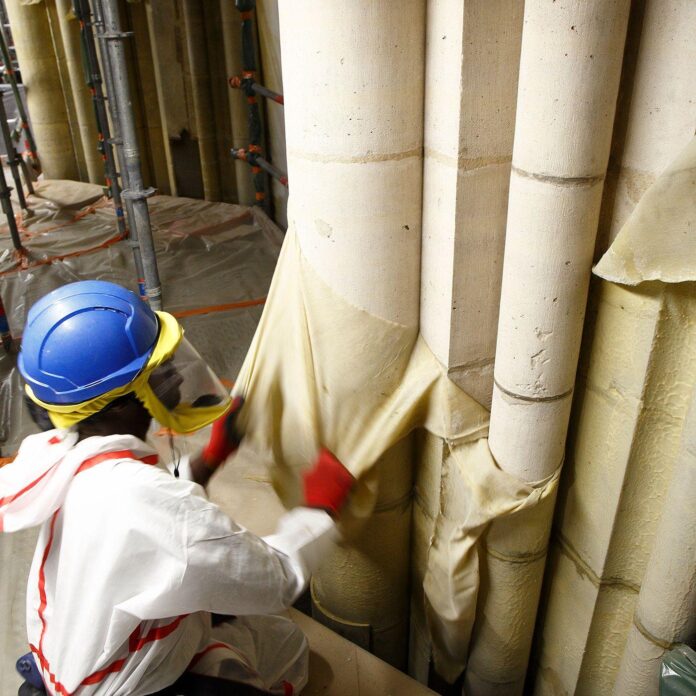With plans for its revamp already denounced as more Disneyland than devotional, the interior of the Notre Dame cathedral in Paris is set to deliver further surprises when it reopens its doors in 2024. At a public engagement event to mark the 39th edition of European Heritage Days, Jean-Louis Georgelin, an army general charged with organising the restoration of Notre Dame, said that after centuries of neglect, the newly cleaned interior would be “a shock”.
The current cleaning phase involves the application of a latex paste to the interior stonework. After a few days, the latex can be peeled off, bringing with it accumulated dust and dirt. Speaking toThe Times in September Philippe Villeneuve, the chief architect of French national historic monuments, said that once completed the cathedral would be “luminous”.
Latex was developed as a cleaning material for historic stonework in the 1990s, and was first used in the UK at St Paul’s Cathedral during a 15-year restoration campaign completed in 2011. Here, latex served as the carrying agent for active agents dipotassium EDTA and ammonia in a product called Arte Mundit, a paste developed by the now defunct Belgian company FTB Restoration and deemed to be the “most efficacious” cleaning method for St Paul’s Cathedral, selected over traditional techniques using water, or abrasives.
In order to speed up its application, Arte Mundit was sprayed on to the stonework and left to dry. But in January 2003, The Times reported that Health and Safety inspectors had been called to the cathedral after cases of skin rashes and respiratory problems among the staff. At the time, the latex content was considered to be the most likely cause of adverse reactions, though low levels of another ingredient, ammonia, can also cause “irritation to the eyes, nose and throat” according to Public Health England. The Times reported that Arte Mundit contained “three more hazardous substances, that can cause rashes, coughs and sore throats”. Spraying at St Paul’s was thereafter confined to night time in order to minimise any further risks.
Rebâtir Notre-Dame de Paris, the public body established in 2019 to supervise the restoration of the French cathedral said: “The latex is applied to all the walls, including the decorations”. The spokesperson said that while previous latex-containing formulations “contained additives or stabilisers such as ammonia, which may have posed difficulties in the past”, formulations had improved in recent years to better protect both buildings and health. Rebâtir Notre-Dame de Paris also confirmed that EDTA was not being used at the cathedral.

The technique being used at Notre Dame—a latex film sprayed on to lift off dirt—caused controversy when employed, with different cleaning agents, on the interiors of St Paul’s Cathedral, in London, in the 1990s © David Bordes / Etablissement public chargé de la conservation et de la restauration de la cathédrale Notre-Dame de Paris
The use of latex, ammonia and EDTA were already controversial in 2003, when they were selected for use at St Paul’s Cathedral. That year, the conservator John Larson expressed “outrage”, pointing out that at that time the application of moulding materials to stone was banned at the V&A and other major collections for fear it could cause damage. He said: “If you judge everything by whether it is looking brighter and cleaner, you’re judging it on the basis of how a bathroom looks.” Both he and Richard Wolbers, then of University of Delaware Conservation, registered concerns in Conservation News (the publication of the United Kingdom Institute for Conservation of Historic and Artistic Works, since amalgamated into the Institute of Conservation), about the use of latex, ammonia and EDTA at the cathedral, the latter having been used controversially in the cleaning of the Sistine Chapel.
Michael Daley, the director of ArtWatch UK, which led opposition to the St Paul’s cleaning said: “There is this constant techno-inflation where the latest method is presented as a super-scientific advance, but only until the next one comes along and it gets changed or superseded.”
The allure of clean stone is as powerful now as it was at St Paul’s Cathedral 20 years ago. On witnessing the cleaning at Notre Dame, the French culture ministry official Jean-Michel Guilment told The Times: “The whiteness underneath the dirt was quite spectacular.” Michael Daley said: “The really important questions in restoration are not, in essence, technical, they are aesthetic and historic and artistic. The question at Notre Dame, as at St Paul’s, is whether there is any good basis for wishing to present an artificially brightened and ahistorical white interior.”
Rebâtir Notre-Dame de Paris dismissed suggestions that they are seeking to achieve a white interior: “Following the fire, a thorough cleaning campaign of all interiors was required. The interior elevations will regain their original colour since the chapels and side aisles were very dirty. It is of course not a white colour: the stone has a blonde colour and the architects are very attentive to obtaining a patina that respects the centuries. When it reopens in 2024, pilgrims and visitors from all over the world will find the cathedral more beautiful than ever.”














![Why Aren’t All Art Collectors This Honest? [Cartoon]](https://usaartnews.com/wp-content/uploads/Qil7plZVjtCUPqHsMRs1TthCjrrFytlS2L8E4JJG-80x60.jpg)










